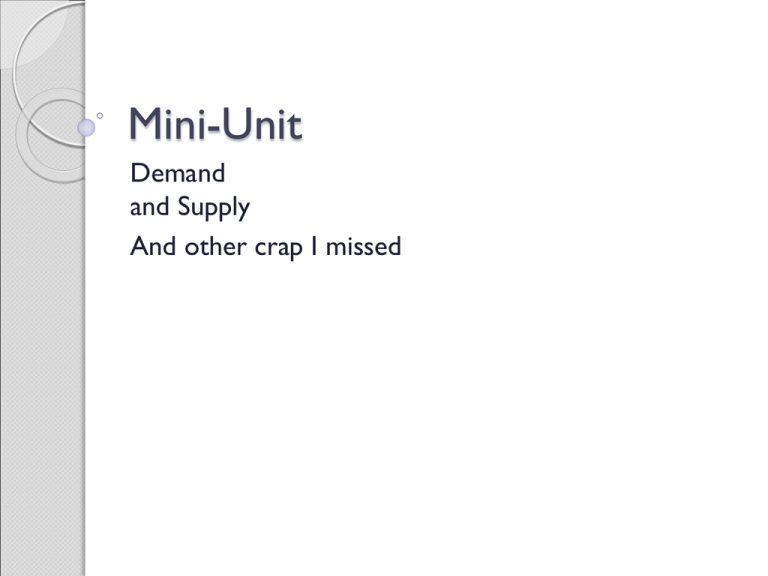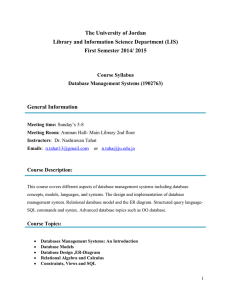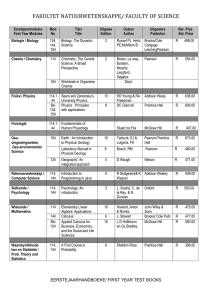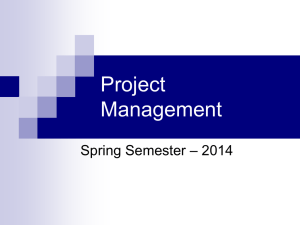
Mini-Unit
Demand
and Supply
And other crap I missed
Introduction
They are small, thin and lightweight…
Some are not aware of their existence, while others
allocate a lot of time and effort in obtaining them.
What are they? They are sports trading cards.
Most can be purchased for a few dollars or less, but many
cost much more—up to thousands of dollars each!
In this chapter you will learn why the prices of different
sports trading cards can vary so widely.
Copyright © 2008 Pearson Addison Wesley.
All rights reserved.
3-2
Supply and Demand
The average price of an apartment-sized
condominium has often exceeded the average
price of a standalone house?
The relative physical size of items does
not determine the prices at which people
exchange them for?
By using demand and supply you can develop a
better understanding of why relative size of an
item typically has little to do with the price at
which it sells?
Copyright © 2008 Pearson Addison Wesley.
All rights reserved.
3-3
Markets
Markets
◦ Arrangements that individuals have for exchanging
with one another
◦ Represent the interaction of buyers and sellers for
goods and services
◦ Markets set the prices we pay and receive.
Automobile market
Health care market
Labor market
Stock market
Copyright © 2008 Pearson Addison Wesley.
All rights reserved.
3-4
The Law of Demand
Demand
◦ A schedule showing how much of a good or
service people will purchase at any price
during a specified time period, other things
being constant
Copyright © 2008 Pearson Addison Wesley.
All rights reserved.
3-5
The Law of Demand
Law of Demand
◦ Quantity demanded is inversely related to
price, holding other factors constant.
Price # Qd $
Price $ Qd #
Copyright © 2008 Pearson Addison Wesley.
All rights reserved.
3-6
The Law of Demand (cont'd)
What are we holding constant?
◦ Income
◦ Tastes and preferences
◦ Price of other goods
◦ Many other factors
If any of these change, then the demand schedule
will shift.
Copyright © 2008 Pearson Addison Wesley.
All rights reserved.
3-7
The Demand Schedule
The demand schedule
◦ Table relating prices to quantity demanded
Demand Curve
◦ A graphical representation of the demand schedule
◦ Negatively sloped line showing inverse
relationship between price and quantity
demanded, all else equal
Copyright © 2008 Pearson Addison Wesley.
All rights reserved.
3-8
Figure 3-1 The Individual Demand Schedule
and the Individual Demand Curve, Panel (a)
Combination
Price per Starbucks
coffee
Quantity of
Starbucks Coffees
consumed/year
A
$5
10
B
$4
20
C
$3
30
D
$2
40
E
$1
50
Copyright © 2008 Pearson Addison Wesley.
All rights reserved.
3-9
Price per coffee
Figure 3-1 The Individual Demand Schedule
and the Individual Demand
Curve, Panel (b)
Number of coffees per year
Copyright © 2008 Pearson Addison Wesley.
All rights reserved.
310
The Demand Schedule
Individual versus market demand curves
Market Demand
◦ The demand of all consumers in the
marketplace for a particular good or service
◦ Summation at each price of the quantity
demanded by each individual
Copyright © 2008 Pearson Addison Wesley.
All rights reserved.
311
Figure 3-2 The Horizontal Summation of
Two Demand Curves, Panel (a)
Combinati
on
Price per
Starbucks
coffee
Quantity of
Starbucks
Coffees
consumed/
year (me)
Quantity of
Starbucks
Coffees
consumed/
year (wife)
Total
Quantity
consumed
A
$5
10
10
20
B
$4
20
20
40
C
$3
30
40
70
D
$2
40
50
90
E
$1
50
60
110
Copyright © 2008 Pearson Addison Wesley.
All rights reserved.
312
Figure 3-2 The Horizontal Summation of
Two Demand Curves, Panels (b), (c), (d)
Copyright © 2008 Pearson Addison Wesley.
All rights reserved.
313
Figure 3-3 The Market Demand Schedule for
Flash Memory Pen
Drives, Panel (a)
Combination
Price per Starbucks
coffee
Quantity of
Starbucks Coffees
consumed/year in
millions
(total population)
A
$5
2
B
$4
4
C
$3
6
D
$2
8
E
$1
10
Copyright © 2008 Pearson Addison Wesley.
All rights reserved.
314
Price per coffee
Figure 3-3 The Market Demand Schedule for
Flash Memory Pen
Drives, Panel (b)
Number of coffees per year
Copyright © 2008 Pearson Addison Wesley.
All rights reserved.
315
Shifts in Demand
Scenario
◦ Imagine a news story runs on all networks
claiming that Starbucks coffee is the only safe
coffee shop open and all others have health
care issues
If some factor other than price changes, we can
show its effect by moving the entire demand curve,
shifting the curve left or right.
Copyright © 2008 Pearson Addison Wesley.
All rights reserved.
316
Figure 3-4
A Shift in the Demand Curve
Suppose Starbucks
has major health
code violations
Price per coffee
Suppose the news
runs a story on other
unsafe coffee shops
Number of coffees per year
Copyright © 2008 Pearson Addison Wesley.
All rights reserved.
317
Shifts in Demand
Determinants of demand
◦ Income
◦ Tastes and preferences
◦ The prices of related goods
Substitutes
Complements
Copyright © 2008 Pearson Addison Wesley.
All rights reserved.
318
Shifts in Demand (cont'd)
Substitutes
◦ Two goods are substitutes when a change in
the price of one causes a shift in demand for
the other in the same direction as the price
change.
Copyright © 2008 Pearson Addison Wesley.
All rights reserved.
319
Shifts in Demand (cont'd)
Complements
◦ Two goods are complements when a change
in the price of one causes an opposite shift in
the demand curve for the other.
Copyright © 2008 Pearson Addison Wesley.
All rights reserved.
320
Shifts in Demand (cont'd)
Determinants of demand
◦ Expectations
Future prices
Income
Product availability
◦ Market size (number of buyers)
Copyright © 2008 Pearson Addison Wesley.
All rights reserved.
321
Normal and Inferior Goods &
Income
Normal Goods
◦ Goods for which demand rises as income
rises, most goods are normal goods
Inferior Goods
◦ Goods for which demand falls as
income rises
Copyright © 2008 Pearson Addison Wesley.
All rights reserved.
322
Shifts in Demand (cont'd)
The Determinants of Demand
Income: Normal Good
Price
Increase in income
increases demand
Decrease in income
decreases demand
D3
D1
D2
Q/Units
Copyright © 2008 Pearson Addison Wesley.
All rights reserved.
323
Shifts in Demand (cont'd)
The Determinants of Demand
Income: Inferior Good
Price
Decrease in income
increases demand
Increase in income
decreases demand
D3
D1
D2
Q/Units
Copyright © 2008 Pearson Addison Wesley.
All rights reserved.
324
Shifts in Demand (cont'd)
The Determinants of Demand
Tastes and Preferences
Price
Hybrid vehicles
• Increase in demand
SUVs
• Decrease in demand
D3
D1
D2
Q/Units
Copyright © 2008 Pearson Addison Wesley.
All rights reserved.
325
Shifts in Demand (cont'd)
The Determinants of Demand
Price of Related Goods: Substitutes
Price
Butter and Margarine
• Price of both = $2/lb
• Price of margarine
increases to $3/lb
• Demand for butter
increases
D1
D2
Q/Butter
Copyright © 2008 Pearson Addison Wesley.
All rights reserved.
326
Shifts in Demand (cont'd)
The Determinants of Demand
Price of Related Goods: Complements
Price
Speakers and Amplifiers
• Decrease the relative
price of amplifiers
• Demand for speakers
increases
Speakers and Amplifiers
• Increase the relative
price of amplifiers
• Demand for speakers
decreases
D3
D1
D2
Q/Speakers
Copyright © 2008 Pearson Addison Wesley.
All rights reserved.
327
Shifts in Demand (cont'd)
The Determinants of Demand
Expectations: Income, Future Prices
Price
A higher income or
expectations of a higher future
price will increase demand
A lower income or
expectations of a lower future
price will decrease demand
D3
D1
D2
Q/Units
Copyright © 2008 Pearson Addison Wesley.
All rights reserved.
328
Shifts in Demand (cont'd)
The Determinants of Demand
Market Size (Number of Buyers)
Price
Increase in the
number of buyers
increases demand
Decrease in the
number of buyers
decreases demand
D3
D1
D2
Q/Units
Copyright © 2008 Pearson Addison Wesley.
All rights reserved.
329
Shifts in Demand (cont'd)
Changes in demand versus changes in
quantity demanded
◦ A change in one or more of the non-price
determinants (income, tastes, etc.) will lead to
a change in demand.
This is a shift of the whole curve.
Copyright © 2008 Pearson Addison Wesley.
All rights reserved.
330
Shifts in Demand (cont'd)
Changes in demand versus changes in
quantity demanded
◦ A change in a good’s own price leads to a
change in quantity demanded.
This is a movement along the same curve.
∆D is not the same as ∆Qd.
Copyright © 2008 Pearson Addison Wesley.
All rights reserved.
331
Figure 3-5 Movement Along a
Given Demand Curve
Price per coffee
A change in the price
changes the quantity
of a good demanded,
movement along the curve
Number of coffees per year
Copyright © 2008 Pearson Addison Wesley.
All rights reserved.
332
The Law of Supply
Supply
◦ Schedule showing relationship between price
and quantity supplied for a specified time
period, other things being equal
◦ The amount of a product or service that firms
are willing to sell at alternative prices
Copyright © 2008 Pearson Addison Wesley.
All rights reserved.
333
The Law of Supply (cont'd)
Law of Supply
◦ The price of a product or service and the
quantity supplied are directly related.
P#
Qs #
P$
Qs $
Copyright © 2008 Pearson Addison Wesley.
All rights reserved.
334
The Supply Schedule
The supply schedule is a table relating prices
to quantity supplied at each price.
Supply Curve
◦ A graphical representation of the
supply schedule
◦ Positively sloped line showing direct relationship
between price and quantity supplied, all else
equal
Copyright © 2008 Pearson Addison Wesley.
All rights reserved.
335
Figure 3-6 The Individual Producer’s Supply
Schedule and Supply Curve for Starbucks Coffee
Combination
Price of Starbucks
Coffee
Quantity of
Starbucks Coffee
Supplied
F
$5
55
G
4
40
H
3
35
I
2
25
J
1
20
Copyright © 2008 Pearson Addison Wesley.
All rights reserved.
336
Price per coffee
Figure 3-6 The Individual Producer’s Supply
Schedule and Supply Curve for Flash Memory
Pen Drives, Panel (b)
Number of coffees per year
Copyright © 2008 Pearson Addison Wesley.
All rights reserved.
337
Figure 3-7 Horizontal Summation
of Supply Curves, Panel (a)
Price per cup of Starbucks #501
Starbucks
coffee
Starbucks #233
Combined
Quantity
Supplied per
year
$5
55
35
90
4
40
30
70
3
35
20
55
2
25
15
40
1
20
10
30
Copyright © 2008 Pearson Addison Wesley.
All rights reserved.
338
Number of
coffees per year
Price per coffee
Price per coffee
Price per coffee
Figure 3-7 Horizontal Summation
of Supply Curves, Panels (b), (c), (d)
Number of
coffees per year
Number of
coffees per year
Copyright © 2008 Pearson Addison Wesley.
All rights reserved.
339
Figure 3-8 The Market Supply Schedule and
the Market Supply Curve for Starbucks Coffee
Price
Quantity of Starbucks Coffee
Supplies
$5
10
$4
8
$3
6
$2
4
$1
2
Copyright © 2008 Pearson Addison Wesley.
All rights reserved.
340
Price per coffee
Figure 3-8 The Market Supply Schedule and
the Market Supply Curve for Flash Memory Pen
Drives, Panel (b)
Number of coffees per year
Copyright © 2008 Pearson Addison Wesley.
All rights reserved.
341
Shifts in Supply
Scenario
◦ A new method of manufacturing flash
memory pen drives reduces the cost of
production dramatically.
Copyright © 2008 Pearson Addison Wesley.
All rights reserved.
342
Figure 3-9
A Shift in the Supply Curve
If some other factor than
price changes, the only
way we can show its
effect is by moving the
entire supply curve
If costs increase,
supply decreases
Price per coffee
If costs decrease,
supply increases
Number of coffees per year
Copyright © 2008 Pearson Addison Wesley.
All rights reserved.
343
Price per coffee
Price per Flash Memory Pen Drive ($)
Figure 3-9
A Shift in the Supply Curve (cont'd)
5
a
4
c
3
S2
S1
When supply increases
the quantity supplied will
be greater at each price
2
1
0
2
4
6
8
10
12
14
Quantity
Memory
Pen Drives Supplied
Number of
ofFlash
coffees
per year
(millions of constant-quality units per year)
Copyright © 2008 Pearson Addison Wesley.
All rights reserved.
344
Price per coffee
Price per Flash Memory Pen Drive ($)
Figure 3-9
A Shift in the Supply Curve (cont'd)
5
a
4
b
c
3
S2
S1
d
When supply increases
the quantity supplied will
be greater at each price
2
1
0
2
4
6
8
10
12
14
Quantity of
of coffees
Flash Memory
Pen Drives Supplied
Number
per year
(millions of constant-quality units per year)
Copyright © 2008 Pearson Addison Wesley.
All rights reserved.
345
Flash Memory Pen Drive ($)
percoffee
Price
per
Price
Figure 3-9
A Shift in the Supply Curve (cont'd)
S3
5
b
4
d
3
a
c
S1
When supply decreases
the quantity supplied will
be less at each price
2
1
0
2
4
6
8
10
12
14
Number
ofofcoffees
per year Pen Drives Supplied
Quantity
Flash Memory
(millions of constant-quality units per year)
Copyright © 2008 Pearson Addison Wesley.
All rights reserved.
346
Shifts in Supply (cont'd)
Determinants of supply
◦ Cost of inputs
◦ Technology and productivity
◦ Taxes and subsidies
◦ Price expectations
◦ Number of firms in industry
Copyright © 2008 Pearson Addison Wesley.
All rights reserved.
347
Shifts in Supply (cont'd)
The Determinants of Supply
Cost of Inputs
Price
Increase in cost
decreases supply
S3
S1
S2
Decrease in cost
increases supply
Q/Units
Copyright © 2008 Pearson Addison Wesley.
All rights reserved.
348
Shifts in Supply (cont'd)
The Determinants of Supply
Technology and Productivity
Price
S3
S1
S2
Decreases in productivity
decrease supply
Improvements in technology or
increases in productivity
increase supply
Q/Units
Copyright © 2008 Pearson Addison Wesley.
All rights reserved.
349
Shifts in Supply (cont'd)
The Determinants of Supply
Taxes and Subsidies
Price
S3
S1
S2
Increases in taxes or
decreases in subsidies
decrease supply
Decreases in taxes or
increases in subsidies
increase supply
Q/Units
Copyright © 2008 Pearson Addison Wesley.
All rights reserved.
350
Policy Example: Import Restrictions
Reduce the Supply of Cement
U.S. cement manufacturers produce more than 80
million metric tons of cement per year.
The rest of the cement supplied—15 to 20 million
metric tons—is imported, much of it from Mexico.
During the 1990s the U.S. government began imposing
an import duty on Mexican cement.
The continuation of this tariff during the 2000s caused
Mexican producers to limit sales to the United States at
any given price, reducing the U.S. supply of cement.
Copyright © 2008 Pearson Addison Wesley.
All rights reserved.
351
Shifts in Supply
The Determinants of Supply
Price Expectations*
Price
S3
S1
S2
Expectations of lower
prices decrease supply
Expectations of higher
future prices decrease
supply
Expectations of lower
future prices increase
supply
Expectations of
increase in price
increases supply
Q/Units
Copyright © 2008 Pearson Addison Wesley.
All rights reserved.
352
Shifts in Supply (cont'd)
The Determinants of Supply
Number of Firms in Industry
Price
Decrease in the
number of firms
decreases supply
S3
S1
S2
Increase in the
number of firms
increases supply
Q/Units
Copyright © 2008 Pearson Addison Wesley.
All rights reserved.
353
Shifts in Supply (cont'd)
Changes in supply versus changes in
quantity supplied
◦ A change in one or more of the non-price
determinants will lead to a change
in supply.
This is a shift of the whole curve.
Copyright © 2008 Pearson Addison Wesley.
All rights reserved.
354
Shifts in Supply (cont'd)
Changes in supply versus changes in
quantity supplied
◦ A change in a good’s own price leads to a
change in quantity supplied.
This is a movement along the same curve.
∆S is not the same as ∆Qs.
Copyright © 2008 Pearson Addison Wesley.
All rights reserved.
355
Putting Demand
and Supply Together
Putting demand and supply together
Equilibrium (Market Clearing) Price
◦ The price that clears the market
◦ The price at which quantity demanded equals
quantity supplied
◦ The price where the demand curve intersects
the supply curve
Copyright © 2008 Pearson Addison Wesley.
All rights reserved.
356
Figure 3-10 Putting Demand and
Supply Together, Panel (a)
Price of
Coffee
Quantity
Supplied in
millions
Quantity
demanded in
millions
Difference
Condition
$5
10
2
8 million
Excess quantity
(surplus)
4
8
4
4 million
Excess quantity
(surplus)
3
6
6
0
Market clearing
(equilibrium)
2
4
8
-4 million
Excess demand
(shortage)
1
2
10
-8 million
Excess demand
Copyright © 2008 Pearson Addison Wesley.
3(shortage) 57
All rights reserved.
Price per coffee
Figure 3-10 Putting Demand and
Supply Together, Panel (b)
Number of coffees per year
Copyright © 2008 Pearson Addison Wesley.
All rights reserved.
358
Putting Demand
and Supply Together (cont'd)
Equilibrium
◦ The situation when quantity supplied equals
quantity demanded at a
particular price
Copyright © 2008 Pearson Addison Wesley.
All rights reserved.
359
Putting Demand
and Supply Together (cont'd)
Shortages
◦ The situation when quantity demanded is
greater than quantity supplied
Q d > Qs
◦ Exist at any price below the market clearing
price
Copyright © 2008 Pearson Addison Wesley.
All rights reserved.
360
Putting Demand
and Supply Together (cont'd)
Surpluses
◦ The situation when quantity supplied is
greater than quantity demanded
Q d < Qs
◦ Exist at any price above the market clearing
price
Copyright © 2008 Pearson Addison Wesley.
All rights reserved.
361
Policy Example: Should Shortages in the
Ticket Market Be Solved by Scalpers?
If you’ve ever tried to get tickets
to the big game you know all
about “shortages.”
Since the quantity of tickets is fixed, the
price can go pretty high.
Enter the scalper.
Copyright © 2008 Pearson Addison Wesley.
All rights reserved.
362
Figure 3-11
Shortages of Super Bowl Tickets
Copyright © 2008 Pearson Addison Wesley.
All rights reserved.
363
Issues and Applications: The Market Clearing
Prices of Baseball Cards
Various companies, such as Topps and Upper Deck, print
sports trading cards that provide photos and stats on
pro athletes.
Why are some of the market clearing prices so high?
The answer has to do with demand and supply.
(A relatively low supply helps explain the relatively high
market clearing price.)
You can buy a “Shoeless” Joe Jackson card for up
to $9,000!
Copyright © 2008 Pearson Addison Wesley.
All rights reserved.
364
Table 3-2 Baseball Cards with the
Highest Market Clearing Prices
Copyright © 2008 Pearson Addison Wesley.
All rights reserved.
365








